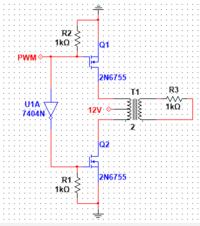DasPreetam
Advanced Member level 4

- Joined
- Jan 5, 2014
- Messages
- 100
- Helped
- 2
- Reputation
- 4
- Reaction score
- 2
- Trophy points
- 18
- Activity points
- 755
I'm trying to design a DC-AC Pure sine wave power inverter which will take 12 V DC from a battery and Provide a 220 Vrms, 50Hz sine wave output. I've seen many references, but most of them are either square wave or modified square wave.
I've designed a bubba oscillator using LM348 which produces a 50Hz sine wave. But it's amplitude is only 1Vpk. If I connect it directly to a step-up transformer will it work ?
Also, I have another question. In multisim, I'm giving a Vcc/2 offset to the non-inverting terminal of the op-amp. How can I achieve this in real-life ?
The transformer in multisim is stepping up the output along with DC offset... How's that possible ? I thought that the transformer will only step up the AC component !
I've designed a bubba oscillator using LM348 which produces a 50Hz sine wave. But it's amplitude is only 1Vpk. If I connect it directly to a step-up transformer will it work ?
Also, I have another question. In multisim, I'm giving a Vcc/2 offset to the non-inverting terminal of the op-amp. How can I achieve this in real-life ?
The transformer in multisim is stepping up the output along with DC offset... How's that possible ? I thought that the transformer will only step up the AC component !





